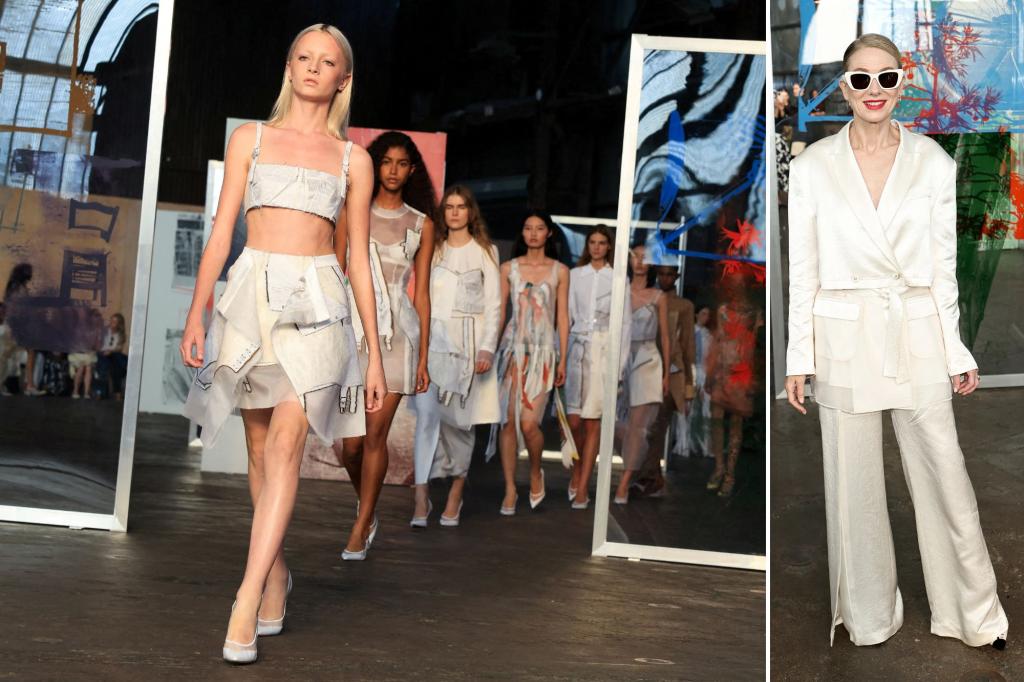Jason Wu’s Spring 2026 Collection: Where Fashion Meets Fine Art
In a stunning display of artistic innovation, designer Jason Wu has once again proven his mastery of the fashion medium with his spring 2026 ready-to-wear collection titled “Collage.” Collaborating with the prestigious Robert Rauschenberg Foundation, Wu has created a line that beautifully blurs the boundaries between wearable fashion and fine art. The collection draws profound inspiration from Rauschenberg’s fabric-focused Hoarfrost series (1974-76) and Airport Suite editions (1974), both known for their experimental approach to textiles and mixed media. Wu’s interpretation manifests in pieces that layer translucent fabrics, incorporate solvent-transferred images, and feature unexpected materials – creating garments that are as much artistic statements as they are fashion items. This collaboration represents a meaningful dialogue between contemporary fashion and 20th-century art history, with Wu skillfully translating Rauschenberg’s revolutionary artistic techniques into the language of modern couture.
The collection’s debut took place in the expansive Agger Fish building at the Brooklyn Navy Yard, a raw industrial space that provided the perfect backdrop for Wu’s artistic vision. Opening the show was Kai Schreiber, the 16-year-old daughter of Hollywood stars Naomi Watts and Liev Schreiber, whose platinum blonde appearance marked her fifth high-profile runway this season following turns at Calvin Klein and Michael Kors. Despite her youth, Schreiber demonstrated remarkable poise and professionalism as she navigated the runway with the confidence of a seasoned model. Her mother watched proudly from the front row, surrounded by a constellation of celebrities including Danai Gurira, Devon Windsor, Larsen Thompson, and Lily Rabe with husband Hamish Linklater. “She’s doing a great job,” Watts commented about her daughter, adding, “She’s been practicing for this a long time. She’s a dancer as well and she loves fashion.” This touching maternal pride added a human element to the high-concept fashion presentation, reminding viewers of the personal connections that exist even in the most artistic of fashion environments.
The runway presentation itself was an immersive experience that went beyond traditional fashion shows. Models weaved their way through Rauschenberg’s installation “A Quake in Paradise (Labyrinth)” (1994), a complex arrangement of transparent, reflective, and opaque panels featuring the artist’s own photographs alongside Aaron Siskind’s “Divers” from his 1950s “Pleasures and Terrors of Levitation” series. A drone hovered overhead, capturing the movement of models through this artistic maze and adding a contemporary technological element to the presentation. This staging decision brilliantly reinforced the collection’s theme of layering and transparency while physically immersing the audience in Rauschenberg’s artistic world. The symbiotic relationship between the venue, the installation, and the clothing created a multisensory experience that elevated the show beyond mere fashion presentation into the realm of performance art – a fitting tribute to Rauschenberg’s own boundary-pushing artistic practice.
Wu’s garments themselves embodied the spirit of Rauschenberg’s work through their construction and movement. The collection featured swingy strips of washed satin, silk twill, and diaphanous organza that moved gracefully with the models, creating living, breathing sculptures. Wu ingeniously patchworked together various garment types – from intimate pieces like slips and bras to structured jackets and flowing evening gowns – echoing Rauschenberg’s collage techniques. Many pieces showcased delicate embroidery and artisanal finishes that added depth and dimension, contributing to the collection’s poetic and contemplative mood. The technical craftsmanship required to create these mixed-media garments speaks to Wu’s exceptional skill as a designer capable of translating artistic concepts into wearable fashion. The pieces managed to maintain their functionality as clothing while simultaneously achieving the expressive power of art objects – a difficult balance that Wu struck with apparent effortlessness.
The collection represents a meaningful exploration of texture, transparency, and layering – themes central to both fashion and Rauschenberg’s artistic practice. Just as Rauschenberg challenged conventional notions of what constitutes art by incorporating everyday materials into his work, Wu challenges fashion conventions by treating garments as canvases for artistic expression. The translucent layers allow glimpses of what lies beneath, creating a visual dialogue between revelation and concealment that feels both intimate and profound. This interplay of visibility echoes Rauschenberg’s own interest in the semi-transparent qualities of his Hoarfrost series, where images appear to float between layers of fabric. Wu’s adaptation of these concepts into wearable garments demonstrates his deep understanding of both the technical aspects of fashion design and the conceptual foundations of fine art. The collection thus stands as a testament to the potential of fashion as a medium for serious artistic expression – capable of carrying complex ideas while remaining fundamentally wearable.
Like the Rauschenberg compositions that inspired them, Wu’s garments transcend their functional purpose to become works of art in their own right. This collection represents a significant moment in contemporary fashion where the boundaries between disciplines continue to dissolve in exciting and thought-provoking ways. Wu has created clothing that demands to be experienced rather than merely worn – pieces that carry the intellectual weight of fine art while maintaining the grace and utility of high fashion. In doing so, he honors Rauschenberg’s legacy while carving out his own place in the ongoing conversation between art and fashion. As viewers and wearers engage with these garments, they participate in a continuation of Rauschenberg’s artistic vision – one reimagined through Wu’s distinctive fashion lens. The “Collage” collection ultimately stands as a beautiful reminder that at their highest levels, both fashion and art share the same essential purpose: to move us, challenge us, and transform how we see the world around us.


